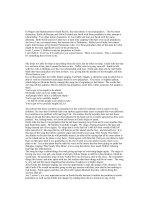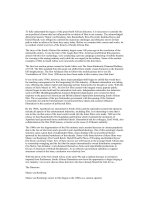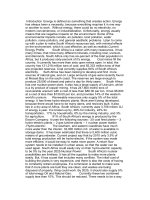south africas energy outlook
Bạn đang xem bản rút gọn của tài liệu. Xem và tải ngay bản đầy đủ của tài liệu tại đây (31.26 KB, 2 trang )
Introduction Energy is defined as something that creates action. Energy
has always been a necessity, because everything requires it in one way
or another to work. Without energy, there could bo no electricity, no
modern convieniences, or industrialization. Unfortunatly, energy usually
means that are negative impacts on the environment. Some of the
environmental impacts include, air pollution, land pollution, water
pollution, noise pollution, and general aesthetic problems. I plan to come
up with a plan to make South Africa's resources last, with minimal effects
on the environment, which is cost effective, as well as realistic.Current
Energy Profile South Africa is a nation with many reasources. It has
many mines, that mine many different minerals, including coal, uranium,
and diamonds. South Africa only has six-percent of the total population in
Africa, but it produces sixty-percent of it's energy. Coal mines fill the
country. It currently has more than sixty open mines open. In total, the
country has 121,218 million tons of coal, and 55,333 million tons of that
are projected reserves. Coal currently supplies 84% of South Africa's
electricity. Suth Africa has been looking to develop and find more
sources of natural gas, and oil. Large amounts of gas were recently found
at Mossel Bay on the south coast. The reserves are large enough to
produce 25,000 of diesel and petrol a day for thirty years. South Africa
has one nuclear power plant. It also has a large supply of Uranuim, which
is a by product of copper mining. It has 247,600 metric tons of
recoverable uranium with a cost of less than $80.00 per ton. It has 96,800
at a cost of less than $130.00 per ton, and provides 14% of the western
world's uranium. Renewable resources only supply 5% of the total
energy. It has three hydro-electric plants. More aren't being developed,
because there would have to be many dams, and resivoirs built. It also
lies in a dry area of Africa. South Africa's currently uses 3,756 miilion GJ
of energy a year. It is broken up by, 48% for industry, 24% for
transportation, 17% by households, 8% by the mining industry, and 3%
for agriculture. 91% of South Africa's energy is produced by the
Escom Company. It uses the following sources 20 coal fired plants 3
hydro-electric plants 2 gas turbine plants 1 nuclear power station
-Hydro-electric: The southern, and eastern coastlines have much
more water than the interior. 33,000 million m3 of water is available in
storage dams. It has been estimated that there is 5,400 million cubic
meters of groundwater. Current project say that by 2010 only 3.5% of
total energy production will be hydro-electric. If the system was made
more efficient, it would be easy to make more power. A return flow
system needs to be installed in urban areas, so that the water can be
used again. South Africa could easily rely on their hydro-electric capacity
to be 5% by the year 2025.Nuclear Power: South Africa's nuclear
possibilities are limitless. It has all the supplies to make more plants
easily. But, it has a past that includes many conflicts. The initail cost of
building the plants is very expensive, and there is also the costs of having
to constantly retrain employees. If a commision is started to make sure
that if more plants are built they are clean, and wastes are being
disposed of properly, thing could work. By 2025, it should also supply 5%
of total enegy.Oil and Natural Gas: Currently these two combined
supply less than 10%. This should be redused. There needs to be a way
to save the resources, because these will be gone in less than 30
years.Biomass: This is one way they can make up for the saving of
oil and natuarl gas. They don't have any biomass production now, so
anything would be better. With 34,000,000 people, the option is
obviously there. It also has a 2/1 yield/cost ratio. Some of the forst would
have to be cut to supply a space for the biomass, and that is a potential
problem, but if planned properly it isn't. 5% of the country's total energy
production should be biomass by 2025.Wind Power: This is what is
really going to do it for South Africa. In the eastern transvaal, winds are
eastern. In the central, winds are north-easterly. In the western and
southern interior, winds are westerly. There are always winds on the
coasts. Large spaces between urban ares are good places for wind
powered generators. As with all wind powered generators, there will be
problems with birds dying, but these are minimal. Wind generators don't
require many workers to run them. I propose that 20% of the electricity
should come from wind by 2025.Solar Power: South Africa also has a
good potential for solatr power. It has a high average tempertaure, and is
a dry country, which means it is usually sunny. The cost are more
expensive than other power sources, but there are no environmental
costs, and it will never run out. The only pollution it has is the dicarding of
batteries, and that isn't very often, and with new ways of disposing
batteries it is very safe. I propose 25% of the power to be supplied from
the sun.Coal:Coal needs to be discontinued slowly. The expotation of
coal, is extremely important to the economy. It would have to be
dicontinued slow enough, so that all the people working in all the aspects
that relate to coal could find new jobs. Coal still needs to provide a large
part of electricity production. The coal the country has is the cleanest
burning, and supplies the most heat, this is good. Mainly coal just needs
to be used less, so that it will last longer. I would like to see that by 2025,
only 30% of the power be from coal.









